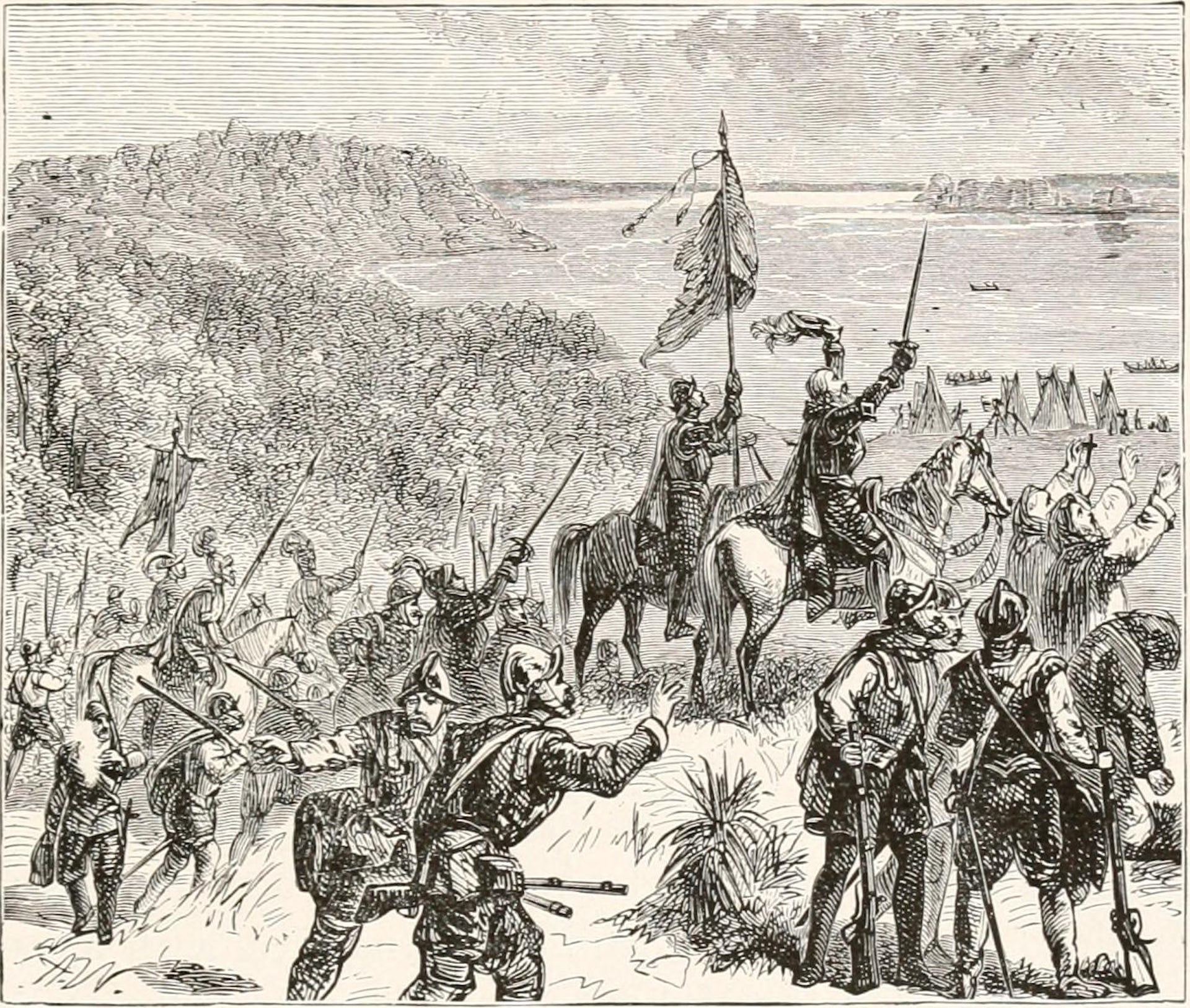Government
The story of Ohio’s ancient Native complex and its long journey for recognition as a World Heritage site
An Indigenous sacred site, Hopewell Ceremonial Earthworks has served as a military barracks, a fairground and, more recently, a golf course.

Hopewell Ceremonial Earthworks in Ohio was added to UNESCO’s list of World Heritage sites on Sept. 19, 2023. The eight mound complexes that received this designation are spread across central and southern Ohio and were built between the beginning of the common era and the 12th century.
The mounds are marvels of Indigenous science and astronomy, which helped Native Americans organize everything from cycles of planting and hunting to their ritual calendar.
But two of the mound complexes, Newark and Serpent Mound, which were not controlled by either the National Park Service or the Ohio History Connection, the state’s historical society and museum, were treated poorly.
Newark has an approximately 2,000-year-old series of geometric enclosures, the largest series in the world. These enclosures include a circular mound connected by a walled road that leads to an octagon-shaped mound at the site. Physicist and astronomer Ray Hively and philosopher Robert Horn have demonstrated that “the four vertices of the octagon form a square whose sides matches the diameter of the circle.” The symmetry of the circle and octagon charts nearly perfectly the lunar nodal cycle, which takes 18.6 years to complete.
Serpent Mound lies 125 miles to the south of Newark. It is a nearly 1,400-foot-long effigy of a coiled serpent that also tracks the summer and winter solstice.
As a historian and ethnographer of the Native American Midwest, I have documented Native peoples’ commitment to their original homelands. The long journey toward this recognition tells a larger story about imperiled Native American sacred sites in the eastern half of the United States and the challenges faced by those who wish to protect them.
American settlers and Native peoples
Native nations originally from east of the Mississippi River largely lost control of their sacred sites as a result of the Indian Removal Act of 1830.
The policy resulted in the wholesale replacement of Native Americans with settlers in nearly every corner of the eastern half of the United States. Three of the Native nations that have helped win the World Heritage designation for the mounds – the Shawnee, Potawatomi and Miami Nation – were subject to removal.
In 1831, soldiers forced Shawnee villagers in northeastern Ohio to move from their land. Seven years later, the U.S. Army compelled 859 Potawatomis from northern Indiana to leave – an event, known as the “Trail of Death,” that resulted in the deaths of more than 40 of their people. And in 1846, American settlers forced the Miami Nation out of their homes along the Wabash River, in Indiana. They ultimately accepted a reservation in Oklahoma.
This policy was widespread: Only one nation, the Sac & Fox Tribe of the Mississippi in Iowa, or Meskwaki, remains headquartered in the lower Midwest.
The forced expulsion of Native nations from their homelands made it difficult for them to protect their sacred heritage. For example, the Eastern Shawnee Tribe of Oklahoma is headquartered roughly 750 miles from the Hopewell Ceremonial Earthworks, which many Shawnees and scholars believe was built by the tribe’s ancestors.
Native nations now headquartered in Oklahoma cannot provide the kind of daily protection of their sacred sites that they once did. Instead, they must rely on non-Native allies who now live on their ancestral lands.
Post-removal abuse and neglect
The Newark Earthworks and Serpent Mound illustrate the difficulty of protecting and reclaiming sacred sites for Native nations subjected to removal.
Over the years, Newark became a military barracks, a fairground, and for the past century it has been leased to the Moundbuilders Country Club. Since 1910, an 18-hole golf course has made use of the mound complex.
Ephraim Squier was the first archaeologist to study Newark, in the 1840s. At the time, most Americans believed that the Bible was the literal word of God and that white Americans were a superior race. Both beliefs shaped archaeological theory. Squier argued that the Toltecs built the mounds and then migrated to Mesoamerica, where they built the great monuments of Mexico and Guatemala. He did not believe that the Indigenous people of the United States were capable of building the mounds.
Unfortunately, some Americans continue to promote false theories about the mounds, casting doubt on the genius of Indigenous science.
Despite his misgivings, Squier nonetheless acknowledged their beauty and accuracy, writing that “the most skillful engineer of the day” would not be able to replicate the accurate dimensions of these mounds.
In the 19th century, Serpent Mound was partially destroyed by farmers. Then, in the the 20th century, two private, nonprofit corporations, Friends of Serpent Mound and Arc of Appalachia, started to manage the site.
These organizations sponsored events in which New Age groups buried crystals in Serpent Mound, lit luminaria around the base of the serpent and conducted summer and winter solstice celebrations they called Star Knowledge Peace Summits. “The crystal people and the New-Agers had taken over the place,” said one park ranger I interviewed in 2022.
Chief Glenna Wallace of the Eastern Shawnee Tribe of Oklahoma has described these practices as desecrations that were conducted without their consent. “My ancestors treasured these mounds. They were sacred. No, they did not build them but they loved them, protected them, revered them,” she wrote.
When she first visited Newark in June 2007, there was a golf tournament underway. Instead of welcoming her, she recalls golfers shouting, “Get back! You’re in the way!” as she attempted to admire her ancestors’ creation.
Collaboration and hope for the future
The fight to protect the Hopewell Ceremonial Earthworks represents more than 25 years of hard work. Citizens of Native nations who were forcibly removed to Oklahoma collaborated with Native and non-Native allies affiliated with the Newark Earthworks Center – an academic center at Ohio State University, Newark campus – and the Ohio History Connection to protect and research the mounds.

Since 2020, the Ohio History Connection, which took over management of Serpent Mound, has been doing community-engaged archaeology. As part of this engagement, staff archaeologists work with the cultural preservation officers of affiliated Native nations to interpret the site.
Similarly, the staff of the Ohio History Connection and the Newark Earthworks Center regularly consult with tribal leaders regarding the Newark Earthworks. These diverse stakeholders worked together for the World Heritage designation.
The fight over the Newark Earthworks has proved far more difficult. The golf club has a century-long lease with the state of Ohio, which the state attempted to terminate through eminent domain. In response, Moundbuilders Country Club sued the Ohio History Connection, arguing that the state of Ohio did not have the right to take private property and convert it to public use.
In May 2019, Licking County Common Pleas Court Judge David Branstool concluded that “100 years of manicured lawns does not immunize the Country Club from eminent domain.” In short, the public’s right to access and appreciate the site is more important than the right of country club members to play golf on the mounds.
In December 2022, the Moundbuilders Country Club appealed the decision to the Ohio Supreme Court and lost. Now both sides await a trial to determine how much money the Ohio History Connection must pay to the club to finally control the mound complex.
Nonetheless, there is much to celebrate now that the Hopewell Ceremonial Earthworks has been named the 25th World Heritage site in the United States. The collaborative partnership between Native nations removed from Ohio, the Ohio History Connection, the National Park Service and dedicated archaeologists in the state serves as a hopeful example of how sacred sites in the eastern half of the United States might be better protected, and interpreted, in the future.
Stephen Warren does not work for, consult, own shares in or receive funding from any company or organization that would benefit from this article, and has disclosed no relevant affiliations beyond their academic appointment.
army mexicoGovernment
Are Voters Recoiling Against Disorder?
Are Voters Recoiling Against Disorder?
Authored by Michael Barone via The Epoch Times (emphasis ours),
The headlines coming out of the Super…

Authored by Michael Barone via The Epoch Times (emphasis ours),
The headlines coming out of the Super Tuesday primaries have got it right. Barring cataclysmic changes, Donald Trump and Joe Biden will be the Republican and Democratic nominees for president in 2024.
With Nikki Haley’s withdrawal, there will be no more significantly contested primaries or caucuses—the earliest both parties’ races have been over since something like the current primary-dominated system was put in place in 1972.
The primary results have spotlighted some of both nominees’ weaknesses.
Donald Trump lost high-income, high-educated constituencies, including the entire metro area—aka the Swamp. Many but by no means all Haley votes there were cast by Biden Democrats. Mr. Trump can’t afford to lose too many of the others in target states like Pennsylvania and Michigan.
Majorities and large minorities of voters in overwhelmingly Latino counties in Texas’s Rio Grande Valley and some in Houston voted against Joe Biden, and even more against Senate nominee Rep. Colin Allred (D-Texas).
Returns from Hispanic precincts in New Hampshire and Massachusetts show the same thing. Mr. Biden can’t afford to lose too many Latino votes in target states like Arizona and Georgia.
When Mr. Trump rode down that escalator in 2015, commentators assumed he’d repel Latinos. Instead, Latino voters nationally, and especially the closest eyewitnesses of Biden’s open-border policy, have been trending heavily Republican.
High-income liberal Democrats may sport lawn signs proclaiming, “In this house, we believe ... no human is illegal.” The logical consequence of that belief is an open border. But modest-income folks in border counties know that flows of illegal immigrants result in disorder, disease, and crime.
There is plenty of impatience with increased disorder in election returns below the presidential level. Consider Los Angeles County, America’s largest county, with nearly 10 million people, more people than 40 of the 50 states. It voted 71 percent for Mr. Biden in 2020.
Current returns show county District Attorney George Gascon winning only 21 percent of the vote in the nonpartisan primary. He’ll apparently face Republican Nathan Hochman, a critic of his liberal policies, in November.
Gascon, elected after the May 2020 death of counterfeit-passing suspect George Floyd in Minneapolis, is one of many county prosecutors supported by billionaire George Soros. His policies include not charging juveniles as adults, not seeking higher penalties for gang membership or use of firearms, and bringing fewer misdemeanor cases.
The predictable result has been increased car thefts, burglaries, and personal robberies. Some 120 assistant district attorneys have left the office, and there’s a backlog of 10,000 unprosecuted cases.
More than a dozen other Soros-backed and similarly liberal prosecutors have faced strong opposition or have left office.
St. Louis prosecutor Kim Gardner resigned last May amid lawsuits seeking her removal, Milwaukee’s John Chisholm retired in January, and Baltimore’s Marilyn Mosby was defeated in July 2022 and convicted of perjury in September 2023. Last November, Loudoun County, Virginia, voters (62 percent Biden) ousted liberal Buta Biberaj, who declined to prosecute a transgender student for assault, and in June 2022 voters in San Francisco (85 percent Biden) recalled famed radical Chesa Boudin.
Similarly, this Tuesday, voters in San Francisco passed ballot measures strengthening police powers and requiring treatment of drug-addicted welfare recipients.
In retrospect, it appears the Floyd video, appearing after three months of COVID-19 confinement, sparked a frenzied, even crazed reaction, especially among the highly educated and articulate. One fatal incident was seen as proof that America’s “systemic racism” was worse than ever and that police forces should be defunded and perhaps abolished.
2020 was “the year America went crazy,” I wrote in January 2021, a year in which police funding was actually cut by Democrats in New York, Los Angeles, San Francisco, Seattle, and Denver. A year in which young New York Times (NYT) staffers claimed they were endangered by the publication of Sen. Tom Cotton’s (R-Ark.) opinion article advocating calling in military forces if necessary to stop rioting, as had been done in Detroit in 1967 and Los Angeles in 1992. A craven NYT publisher even fired the editorial page editor for running the article.
Evidence of visible and tangible discontent with increasing violence and its consequences—barren and locked shelves in Manhattan chain drugstores, skyrocketing carjackings in Washington, D.C.—is as unmistakable in polls and election results as it is in daily life in large metropolitan areas. Maybe 2024 will turn out to be the year even liberal America stopped acting crazy.
Chaos and disorder work against incumbents, as they did in 1968 when Democrats saw their party’s popular vote fall from 61 percent to 43 percent.
Views expressed in this article are opinions of the author and do not necessarily reflect the views of The Epoch Times or ZeroHedge.
Government
Veterans Affairs Kept COVID-19 Vaccine Mandate In Place Without Evidence
Veterans Affairs Kept COVID-19 Vaccine Mandate In Place Without Evidence
Authored by Zachary Stieber via The Epoch Times (emphasis ours),
The…

Authored by Zachary Stieber via The Epoch Times (emphasis ours),
The U.S. Department of Veterans Affairs (VA) reviewed no data when deciding in 2023 to keep its COVID-19 vaccine mandate in place.
VA Secretary Denis McDonough said on May 1, 2023, that the end of many other federal mandates “will not impact current policies at the Department of Veterans Affairs.”
He said the mandate was remaining for VA health care personnel “to ensure the safety of veterans and our colleagues.”
Mr. McDonough did not cite any studies or other data. A VA spokesperson declined to provide any data that was reviewed when deciding not to rescind the mandate. The Epoch Times submitted a Freedom of Information Act for “all documents outlining which data was relied upon when establishing the mandate when deciding to keep the mandate in place.”
The agency searched for such data and did not find any.
“The VA does not even attempt to justify its policies with science, because it can’t,” Leslie Manookian, president and founder of the Health Freedom Defense Fund, told The Epoch Times.
“The VA just trusts that the process and cost of challenging its unfounded policies is so onerous, most people are dissuaded from even trying,” she added.
The VA’s mandate remains in place to this day.
The VA’s website claims that vaccines “help protect you from getting severe illness” and “offer good protection against most COVID-19 variants,” pointing in part to observational data from the U.S. Centers for Disease Control and Prevention (CDC) that estimate the vaccines provide poor protection against symptomatic infection and transient shielding against hospitalization.
There have also been increasing concerns among outside scientists about confirmed side effects like heart inflammation—the VA hid a safety signal it detected for the inflammation—and possible side effects such as tinnitus, which shift the benefit-risk calculus.
President Joe Biden imposed a slate of COVID-19 vaccine mandates in 2021. The VA was the first federal agency to implement a mandate.
President Biden rescinded the mandates in May 2023, citing a drop in COVID-19 cases and hospitalizations. His administration maintains the choice to require vaccines was the right one and saved lives.
“Our administration’s vaccination requirements helped ensure the safety of workers in critical workforces including those in the healthcare and education sectors, protecting themselves and the populations they serve, and strengthening their ability to provide services without disruptions to operations,” the White House said.
Some experts said requiring vaccination meant many younger people were forced to get a vaccine despite the risks potentially outweighing the benefits, leaving fewer doses for older adults.
“By mandating the vaccines to younger people and those with natural immunity from having had COVID, older people in the U.S. and other countries did not have access to them, and many people might have died because of that,” Martin Kulldorff, a professor of medicine on leave from Harvard Medical School, told The Epoch Times previously.
The VA was one of just a handful of agencies to keep its mandate in place following the removal of many federal mandates.
“At this time, the vaccine requirement will remain in effect for VA health care personnel, including VA psychologists, pharmacists, social workers, nursing assistants, physical therapists, respiratory therapists, peer specialists, medical support assistants, engineers, housekeepers, and other clinical, administrative, and infrastructure support employees,” Mr. McDonough wrote to VA employees at the time.
“This also includes VA volunteers and contractors. Effectively, this means that any Veterans Health Administration (VHA) employee, volunteer, or contractor who works in VHA facilities, visits VHA facilities, or provides direct care to those we serve will still be subject to the vaccine requirement at this time,” he said. “We continue to monitor and discuss this requirement, and we will provide more information about the vaccination requirements for VA health care employees soon. As always, we will process requests for vaccination exceptions in accordance with applicable laws, regulations, and policies.”
The version of the shots cleared in the fall of 2022, and available through the fall of 2023, did not have any clinical trial data supporting them.
A new version was approved in the fall of 2023 because there were indications that the shots not only offered temporary protection but also that the level of protection was lower than what was observed during earlier stages of the pandemic.
Ms. Manookian, whose group has challenged several of the federal mandates, said that the mandate “illustrates the dangers of the administrative state and how these federal agencies have become a law unto themselves.”
Government
Low Iron Levels In Blood Could Trigger Long COVID: Study
Low Iron Levels In Blood Could Trigger Long COVID: Study
Authored by Amie Dahnke via The Epoch Times (emphasis ours),
People with inadequate…

Authored by Amie Dahnke via The Epoch Times (emphasis ours),
People with inadequate iron levels in their blood due to a COVID-19 infection could be at greater risk of long COVID.
A new study indicates that problems with iron levels in the bloodstream likely trigger chronic inflammation and other conditions associated with the post-COVID phenomenon. The findings, published on March 1 in Nature Immunology, could offer new ways to treat or prevent the condition.
Long COVID Patients Have Low Iron Levels
Researchers at the University of Cambridge pinpointed low iron as a potential link to long-COVID symptoms thanks to a study they initiated shortly after the start of the pandemic. They recruited people who tested positive for the virus to provide blood samples for analysis over a year, which allowed the researchers to look for post-infection changes in the blood. The researchers looked at 214 samples and found that 45 percent of patients reported symptoms of long COVID that lasted between three and 10 months.
In analyzing the blood samples, the research team noticed that people experiencing long COVID had low iron levels, contributing to anemia and low red blood cell production, just two weeks after they were diagnosed with COVID-19. This was true for patients regardless of age, sex, or the initial severity of their infection.
According to one of the study co-authors, the removal of iron from the bloodstream is a natural process and defense mechanism of the body.
But it can jeopardize a person’s recovery.
“When the body has an infection, it responds by removing iron from the bloodstream. This protects us from potentially lethal bacteria that capture the iron in the bloodstream and grow rapidly. It’s an evolutionary response that redistributes iron in the body, and the blood plasma becomes an iron desert,” University of Oxford professor Hal Drakesmith said in a press release. “However, if this goes on for a long time, there is less iron for red blood cells, so oxygen is transported less efficiently affecting metabolism and energy production, and for white blood cells, which need iron to work properly. The protective mechanism ends up becoming a problem.”
The research team believes that consistently low iron levels could explain why individuals with long COVID continue to experience fatigue and difficulty exercising. As such, the researchers suggested iron supplementation to help regulate and prevent the often debilitating symptoms associated with long COVID.
“It isn’t necessarily the case that individuals don’t have enough iron in their body, it’s just that it’s trapped in the wrong place,” Aimee Hanson, a postdoctoral researcher at the University of Cambridge who worked on the study, said in the press release. “What we need is a way to remobilize the iron and pull it back into the bloodstream, where it becomes more useful to the red blood cells.”
The research team pointed out that iron supplementation isn’t always straightforward. Achieving the right level of iron varies from person to person. Too much iron can cause stomach issues, ranging from constipation, nausea, and abdominal pain to gastritis and gastric lesions.
1 in 5 Still Affected by Long COVID
COVID-19 has affected nearly 40 percent of Americans, with one in five of those still suffering from symptoms of long COVID, according to the U.S. Centers for Disease Control and Prevention (CDC). Long COVID is marked by health issues that continue at least four weeks after an individual was initially diagnosed with COVID-19. Symptoms can last for days, weeks, months, or years and may include fatigue, cough or chest pain, headache, brain fog, depression or anxiety, digestive issues, and joint or muscle pain.
-

 Uncategorized2 weeks ago
Uncategorized2 weeks agoAll Of The Elements Are In Place For An Economic Crisis Of Staggering Proportions
-

 Uncategorized1 month ago
Uncategorized1 month agoCathie Wood sells a major tech stock (again)
-

 Uncategorized3 weeks ago
Uncategorized3 weeks agoCalifornia Counties Could Be Forced To Pay $300 Million To Cover COVID-Era Program
-

 Uncategorized2 weeks ago
Uncategorized2 weeks agoApparel Retailer Express Moving Toward Bankruptcy
-

 Uncategorized3 weeks ago
Uncategorized3 weeks agoIndustrial Production Decreased 0.1% in January
-

 International2 days ago
International2 days agoWalmart launches clever answer to Target’s new membership program
-

 International2 days ago
International2 days agoEyePoint poaches medical chief from Apellis; Sandoz CFO, longtime BioNTech exec to retire
-

 Uncategorized3 weeks ago
Uncategorized3 weeks agoRFK Jr: The Wuhan Cover-Up & The Rise Of The Biowarfare-Industrial Complex















